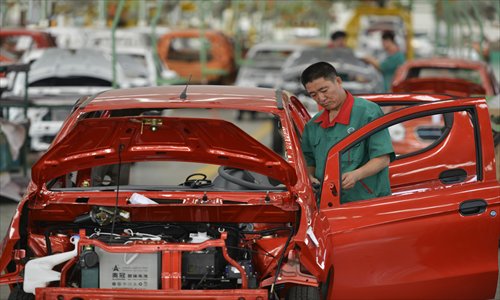China accelerates green vehicle development
More support policies released

A man assembles a new-energy car at a factory in Zouping County, East China's Shandong Province on Wednesday. Photo: CFP

The State Council, China's cabinet, announced a set of support guidelines on Monday aimed at augmenting the country's new-energy vehicle market which has performed far below the government's expectations.
The measures are designed to promote the development of pure electric vehicles, plug-in hybrid vehicles and fuel-cell vehicles, according to the guidelines published on the central government's website.
The cabinet will release a unified standard and a name list of qualified new-energy vehicle makers nationwide so as to prevent the local governments from adopting protectionist policies, which have previously restricted new-energy vehicles produced in other areas from entering their own local markets.
Automakers welcomed the removal of diverse set of standards and listing of qualified new-energy vehicle put in place by local governments.
"Our plug-in hybrid vehicles will enter into more markets such as Beijing if unified standards are adopted nationwide," Li Yunfei, deputy general manager for domestic sales at Chinese electric vehicle maker BYD Co, told the Global Times Monday.
Li thinks China's new-energy vehicle sector will benefit "a lot" from the new guidelines released by the cabinet.
The cabinet encouraged private capital to join in the construction of after-sale system for electric vehicles, including battery rental and recycling, according to the guidelines.
The Internet companies are also welcomed to join in the development of new-energy vehicles so as to speed up the application of smart grid, mobile Internet and big data in the green vehicle sector.
The guidelines, which came after a slew of support policies released by the central government in July, also reiterated government plans to encourage the purchase of new-energy vehicles by government organs.
At least 30 percent of new vehicles for public transportation including buses and taxies should be new-energy vehicles; and new-energy vehicle purchases by local governments should account for no less than 30 percent of their total number of vehicles from 2014 to 2016, according to the guidelines.
On July 9, the State Council also decided at an executive meeting to scrap purchase taxes on new-energy vehicles starting from September 1.
Except for the current technical difficulties faced by new-energy vehicle makers, "most of the other obstacles that used to hamper development of new-energy vehicles in China will be removed if all the guidelines are strictly executed," Gao Jian, an analyst at Shanghai-based consultancy LMC Automotive, told the Global Times on Monday.
To speed up the construction of supporting facilities for the new-energy vehicles, the cabinet ordered the local governments to install charging points at public areas including parking places and encouraged both the local governments and grid enterprises to build related power grids, according to the guidelines.
The guidelines also encouraged building of charging facilities on highways.
Some consumers thought having more charging points will be "very helpful," although it may possibly take a long time to install them.
"It will be more convenient for our drivers if more charging points are installed by the governments," Yu Xinquan, founder and CEO of Inner Mongolia Langlaile E-commerce Co, one of the first owners of Tesla Model S electric cars in China, told the Global Times Monday.
Yu picked up his Tesla Model S this June and installed a charging point at home. And he has planned to buy around 30 charging points and install them in the grasslands in August to encourage more users to drive electric vehicles.
"I can't wait for the government to install more charging points," Yu noted.